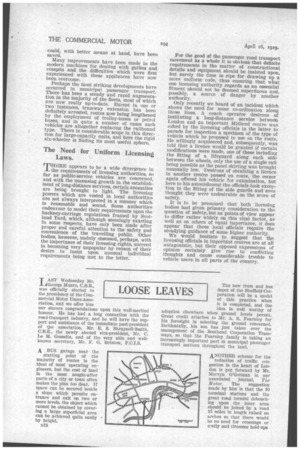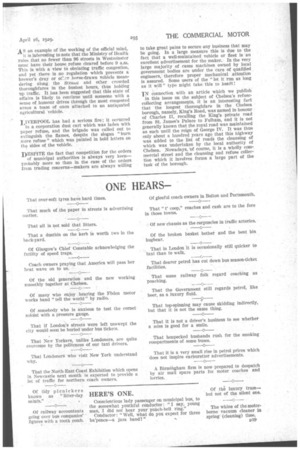T AST Wednesday Mr. LAGeorge Munro, C.B.E., was officially elected
Page 88

Page 89

If you've noticed an error in this article please click here to report it so we can fix it.
to the presidency of the Commercial Motor Users-Association, and we offer him our sincere congratulations upon this well-merited honour. He has had a long connection with the road-transport industry, and he will have the support and assistance of the immediate past-president of the association, Mr. E. S. Shrapriell-Smith, C.B.E., the newly elected vice-president, Mr. C. Le M. Gosselin, and of the very able and wellknown secretary, Mr. F. G. Bristow, F.C.I.S.
A BUS garage near the
starting point of the majority of routes is the ideal of most operating engineers, but the cost of land in the most sought-after parts of a city or town often makes the plan too dear. If space can be secured beside a slope which permits entrance and exit on two or more levels, the object which cannot be obtained by covering a large superficial area can be achieved quite easily by height.
n18
The new tram and bus depot of the Sheffield Corporation will be a model of this practice when it is completed, and the idea is well worthy of adoption elsewhere when ground levels permit. Great credit attaches to Mr. A. It. Fearnley for his foresight in selecting the ground concerned. Incidentally, his son has just taken over the management of the Southend Corporation Tramways, so that the Fearnley family is taking an increasingly important part in municipal passenger transport matters throughout the land.
ANOTHER scheme for the
reduction of traffic congestion in the heart of London is -put forward by Mr. Mervyn O'Gorman in our associated journal, Tice Motor. The suggestion made by himis that the 10 terminal stations and the great road termini debouching upon the inner area should be joined by a road 15 miles in length raised on arches so that therewould be no need for crossings or costly and tiresome hold-ups. AS an example of the Working a the official mind, it is. interesting to note that the Ministry of Health rules that no fewer than 96 streets in Westminster must have their house refuse cleared before P a.m. This is with a view to obviating traffic congestion, and yet there is no regulation which prevents a' brewer's dray or otlIfT .horse-drawn vehicle meandering along the Strand and other . crowded thoroughfares in the busiest hours, thus holding up traffic. It has been suggested that this state of affairs is likely to continue until someone with a sense of humour drives through the most congested areas a team of oxen attached to an antiquated agricultural 'vehicle.
LIVERPOOL has had a serious fire; it occurred in a corporation dust cart which was laden with paper refuse, and the brigade was called out to extinguish the. flames, despite the slogan "burn more refuse" which was painted in bold letters on the sides of the vehicle.
DESPITE the fact that competition for the orders of municipal authorities is always very keen— probably more so than in the case of the orders from trading concerns—makers are always willing to take great pains to secure any business that may be going. In a large measure this is due to the fact that a well-maintained vehicle or fleet is an excellent advertisement for the maker. In the very large majority of cases machines owned by local government bodies are under the care of qualified engineers, therefore proper mechanical attention is assured. Some users of the "let it ran as long as it will" type might take this to heart!
TN connection with an article which we publish in this issue on the subject of Chelsea's refusecollecting arrangements, it is an interesting fact that -the longest thoroughfare in the Chelsea borough, namely, King's Road, was named in honour of Charles II, recalling the King's private road from St. James's Palace to Fulham, and it is not generally known that the royal road was maintained as such until the reign of George IV. It was thus only about a hundred years ago that this highway was added to the list of roads the cleansing of which was undertaken by the local authority of Chelsea. Nowadays, of course, it is a wholly corn-. mercial street and the cleansing and refuse collection which it involves forms a large part of the task of the borough.








































































































































































































